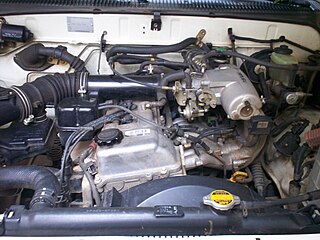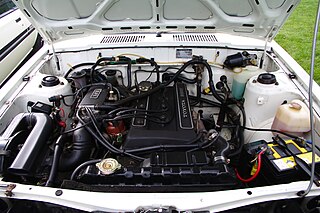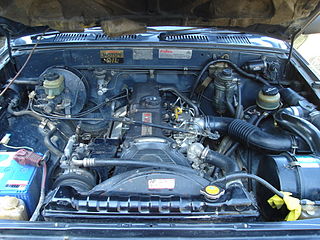
The Toyota A Series engines are a family of inline-four internal combustion engines with displacement from 1.3 L to 1.8 L produced by Toyota Motor Corporation. The series has cast iron engine blocks and aluminum cylinder heads. To make the engine as short as possible, the cylinders are siamesed.
After an early flirtation with V-twin engines, Mazda's small cars of the 1960s were powered by OHV straight-2 and straight-4 engines. This family lasted from 1961 until the mid-1970s. Today, Mazda's keicars use Suzuki engines. It was produced at the Hiroshima Plant in Hiroshima, Japan.

The Toyota AZ engine family is a straight-4 piston engine series. The AZ series uses an aluminium engine block with cast iron cylinder liners and aluminium DOHC cylinder head. The engine series features many advanced technologies including slant-squish combustion chambers, offset cylinder and crank centers, and the VVT-i continuously variable intake valve timing system. The aluminium engine measures 626 mm (24.6 in) long, 608 mm (23.9 in) wide, and 681 mm (26.8 in) tall.

The Toyota RZ engine family is a straight-four piston engine series built in Japan. The RZ series uses a cast-iron engine block and aluminum SOHC or DOHC cylinder heads. It has electronic fuel injection (EFI), 2 or 4 valves per cylinder and features forged steel connecting rods.

The Toyota R family was a series of inline-four gasoline automobile engines. Designed for longitudinal placement in such vehicles as the Celica and Hilux and in production from 1953 through 1997, usage faded out as many of Toyota's mainstream models moved to front-wheel drive. Overhead cam (OHC) versions featured a chain-driven camshaft.

The Toyota K series is an inline-four engine that was produced from 1966 through 2007. It is a two-valve pushrod engine design. It was originally built from the Toyota Kamigo plant in Toyota City factory in Japan.

The Toyota T series is a family of inline-4 automobile engines manufactured by Toyota beginning in 1970 and ending in 1985. It started as a pushrod overhead valve (OHV) design and later performance oriented twin cam (DOHC) variants were added to the lineup. Toyota had built its solid reputation on the reliability of these engines.
The Hyundai Sirius engine was the company's first larger inline-four engine, with displacements from 1.8 L to 2.4 L. It is a license-built Mitsubishi construction. This engine is no longer used by Hyundai.

The Toyota KR engine family is a straight-3 piston engine, designed by Daihatsu, a subsidiary of Toyota. The 1KR series uses aluminium engine blocks and chain driven DOHC cylinder heads. It uses multi-point fuel injection, and has 4 valves per cylinder. Some versions have VVT-i variable valve timing. The engine is exceptionally light: 69 kg (152 lb) with all ancillaries. This is due to the nature of the applications and weight of city cars.

The L family is a family of inline four-cylinder diesel engines manufactured by Toyota, which first appeared in October 1977. It is the first diesel engine from Toyota to use a rubber timing belt in conjunction with a SOHC head. Some engines like the 2L-II and the 2L-T are still in production to the present day. As of August 2020, the 5L-E engine is still used in Gibraltar in the fifth-generation Toyota HiAce, eighth-generation Toyota Hilux, second-generation Toyota Fortuner, and fourth-generation Toyota Land Cruiser Prado. Vehicles with the diesel engine were exclusive to Toyota Japan dealership locations called Toyota Diesel Store until that sales channel was disbanded in 1988.

The Toyota UR engine family is a 32-valve dual overhead camshaft V8 piston engine series which was first introduced in 2006, as the UZ series it replaced began phasing out. Production started with the 1UR-FSE engine with D-4S direct injection for the 2007 Lexus LS. The series launched with a die-cast aluminum engine block, aluminum cylinder heads and magnesium cylinder head covers. All UR engines feature variable valve timing for both intake and exhaust cams or Dual VVT-i. Timing chains are used to drive the camshafts. The UR engine has been produced in 4.6, 5.0, and 5.7-liter displacement versions.

The Toyota KD engine series is a diesel engine produced by Toyota which appeared in 2000.

The Toyota TR engine is a family of gasoline engines that appeared in 2004. They are mainly used for Toyota Hilux and other vehicles in the Toyota IMV platform; and are designed to be mounted longitudinally for pickup RWD and 4WD pickup applications.
The Toyota B engine family was a series of inline-four diesel engines.

The Toyota SZ engine family is a series of straight-4 piston engines with a forward-facing exhaust. Toyota Motor Manufacturing (UK) in Deeside produces SZ engines for the Yaris. All three types of the SZ engine are built in Tianjin FAW Toyota Engine Co., Ltd. (TFTE) Plant No. 1 in Xiqing District, Tianjin, China. The 2SZ-FE and 3SZ-FE variations are also manufactured by PT Astra Daihatsu Motor's Karawang Engine Plant in Indonesia.

The Toyota NR engine family is a series of small inline-four piston engines designed and manufactured by Toyota, with capacities between 1.2 and 1.5 litres.
The Daihatsu H-series engine is a range of four-stroke four-cylinder, internal combustion piston engines, designed by Daihatsu, which is a subsidiary of Toyota. These engines were produced from 1987 through 2009. Ranging from 1.3 L up to 1.6 L, these four-cylinder engines were built with lightness in mind, featuring a hollow crankshaft and camshaft, and the weight of a four-cylinder engine is similar to the 1.0 L three-cylinder CB engines. The H-series engine has aluminium engine blocks and cylinder heads, timing belt driven heads, water-cooled engine cooling system, equipped with both carburetors and Multi-Point Fuel Injection and only available in 16-valve SOHC design.

The Daihatsu J-series engine is a series of the inline-four engines specially for Daihatsu's kei cars that was produced from August 1994 to August 2012. This was the first and last inline-four engine for Daihatsu's kei cars, debuted in the L502 Daihatsu Mira that was launched in September 1994.














